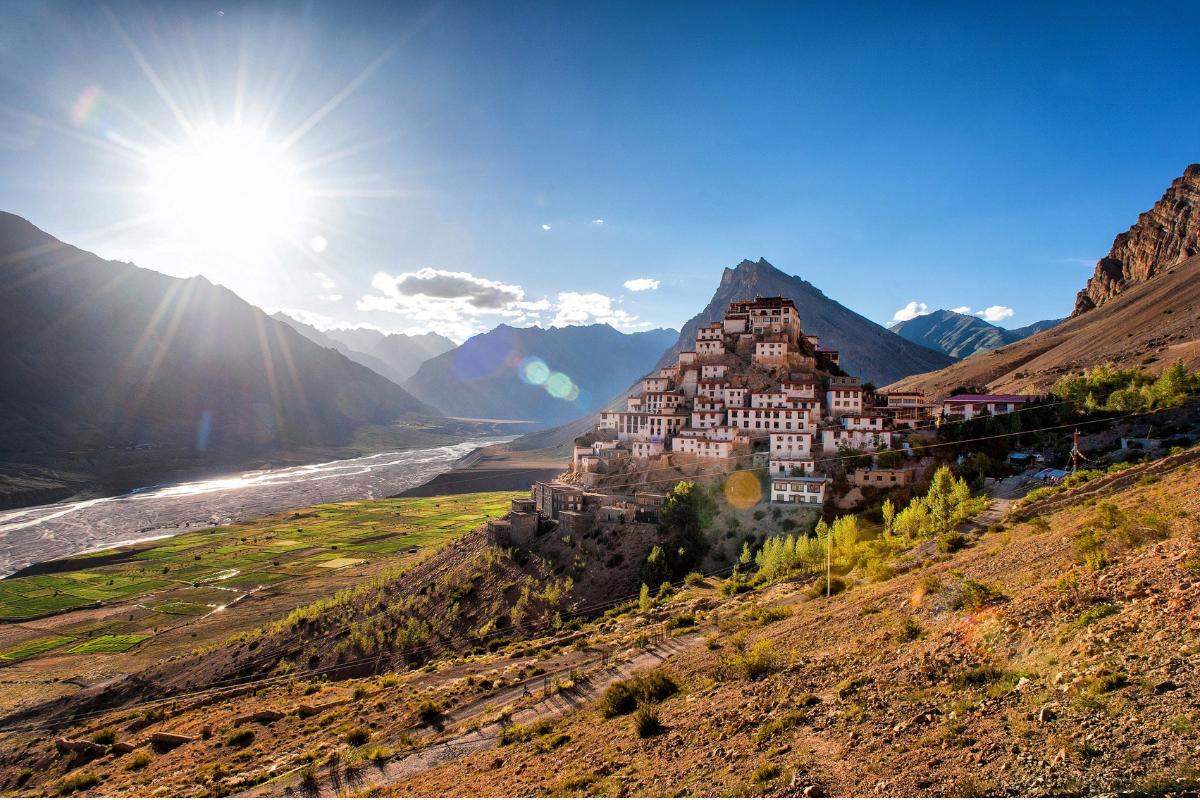Key Monastery: A Spiritual Marvel in the Himalayas
Nestled in the breathtaking Spiti Valley of Himachal Pradesh, Key Monastery (also spelled as Ki, Kee, or Kye) stands as a timeless symbol of Tibetan Buddhist heritage, resilience, and spiritual enlightenment. With its stunning hilltop location at an altitude of 4,166 meters (13,668 feet) above sea level, this monastery is the largest and most important religious institution in Spiti.
Dating back to the 11th century, Key Monastery has withstood invasions, natural calamities, and political turmoil, yet remains an active center for Buddhist learning. The monastery houses priceless ancient manuscripts, vibrant murals, rare thangkas, and an awe-inspiring collection of Buddha idols.
Historical Significance of Key Monastery
Key Monastery’s origins trace back to the 11th century, and it is believed to have been founded by Dromton, a disciple of Atisha, the great Buddhist scholar. Over the centuries, the monastery has endured several invasions and attacks from Mongol invaders and suffered destruction due to earthquakes and fires. Despite these adversities, it has been meticulously restored and continues to thrive as a key hub for Buddhist teachings.
During the 17th century, the monastery was reconstructed in the fortified Tibetan architectural style, a reflection of the tumultuous times when monasteries doubled as fortresses to protect against invaders. The monastery still retains its unique structure with a series of interconnected rooms, narrow corridors, and prayer halls stacked atop one another, resembling a traditional Tibetan fort.
Architectural Grandeur of Key Monastery
One of the most fascinating aspects of Key Monastery is its unique architectural style, which showcases an amalgamation of Tibetan, Indo-Tibetan, and monastic influences. The structure is built in the form of a fortress with several whitewashed buildings stacked in a pyramidal fashion.
Key Features of the Monastery’s Architecture:
- Multi-Tiered Structure: The monastery has a layered layout, consisting of prayer halls, courtyards, residential quarters, and meditation chambers.
- Ancient Murals and Thangkas: The walls are adorned with centuries-old murals, intricate frescoes, and religious paintings that depict Buddhist deities and teachings.
- Library and Scripture Collection: Key Monastery holds rare Tibetan texts and Buddhist scriptures, some of which date back over 1,000 years.
- Prayer Halls and Stupas: Inside the monastery, one can witness massive prayer halls, stunning stupas, and sacred relics.
- Golden Buddha Statue: A magnificent golden idol of Buddha is enshrined in the main prayer hall, exuding an aura of serenity.
Religious and Cultural Importance
Key Monastery serves as the spiritual and cultural epicenter of Spiti Valley. It belongs to the Gelugpa (Yellow Hat) sect of Tibetan Buddhism, the same lineage followed by the Dalai Lama.
Functions and Role in Buddhism:
- Monastic Training Center: Key Monastery is home to over 300 lamas (monks) who undergo rigorous training in Buddhist philosophy, meditation, and rituals.
- Daily Prayers and Rituals: The monastery reverberates with the sound of monastic chants, the blowing of conch shells, and the rhythmic beats of Tibetan drums.
- Annual Festivals: One of the highlights of Key Monastery is the Key Cham Festival, where monks perform masked dances (Cham Dance) to symbolize the triumph of good over evil.
- Pilgrimage Destination: Thousands of devotees and travelers visit the monastery to seek spiritual wisdom, experience tranquility, and witness Buddhist traditions.
How to Reach Key Monastery
Key Monastery is located 14 km from Kaza, the administrative capital of Spiti Valley. Despite its remote location, it is accessible via multiple routes:
By Road:
- From Manali: Drive via Rohtang Pass and Kunzum Pass (200 km, 8-10 hours).
- From Shimla: Take the NH-505 route via Reckong Peo and Kinnaur (450 km, 15-16 hours).
- From Kaza: Taxis and buses operate regularly, covering the 14 km stretch in about 30-40 minutes.
By Air:
- The nearest airport is Bhuntar Airport (Kullu-Manali Airport), about 250 km away.
- Alternatively, Shimla Airport is around 450 km from Spiti Valley.
By Rail:
- The nearest railway station is Joginder Nagar Railway Station, but Chandigarh and Kalka stations are more practical options due to better connectivity.
Best Time to Visit Key Monastery
The ideal time to visit Key Monastery is from May to September, when the roads are accessible, and the weather is pleasant.
- Summer (May – July): Best time to explore the monastery and Spiti Valley under clear blue skies.
- Monsoon (August – September): The region experiences minimal rainfall, making travel feasible.
- Winter (October – April): The monastery remains open, but harsh winter conditions with sub-zero temperatures make travel challenging.
Experiences Around Key Monastery
1. Stay at the Monastery
Visitors can stay overnight at Key Monastery, experiencing monastic life firsthand. The accommodation is basic, with simple dormitories and traditional meals.
2. Interact with Monks
Engage with monks to learn about Tibetan Buddhism, meditation techniques, and their daily routines.
3. Explore Nearby Attractions
- Chicham Bridge: The highest suspension bridge in Asia, offering spectacular views.
- Kibber Village: A scenic high-altitude village known for snow leopards and Himalayan wildlife.
- Langza Village: Famous for fossil hunting and a massive Buddha statue.
- Hikkim: Home to the world’s highest post office.
4. Photography and Trekking
Capture the stunning landscapes of Spiti Valley, with its barren mountains, winding rivers, and snow-capped peaks. Trekking routes around Key Monastery offer thrilling adventures for nature lovers and trekkers.
Conclusion
Key Monastery is more than just an architectural marvel; it is a gateway to spirituality, Tibetan culture, and unparalleled Himalayan beauty. Whether you seek spiritual enlightenment, cultural immersion, or a journey into the pristine landscapes of Spiti, this monastery remains an unmissable destination.






